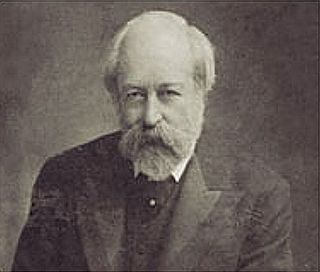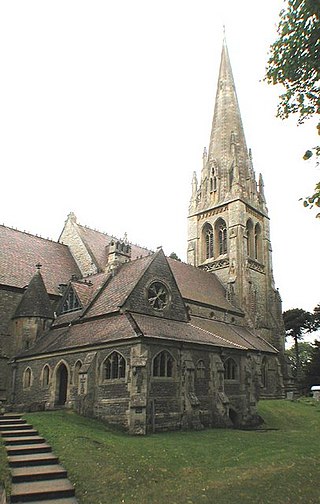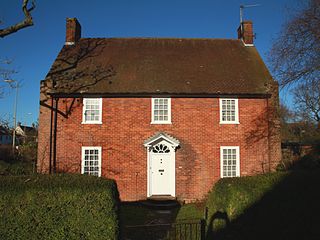Daniel Robertson | |
|---|---|
 | |
| Died | 1849 |
| Nationality | British |
| Occupation | Architect |
Daniel Robertson (died 1849) was a British architect.
Daniel Robertson | |
|---|---|
 | |
| Died | 1849 |
| Nationality | British |
| Occupation | Architect |
Daniel Robertson (died 1849) was a British architect.
Robertson may have worked under Robert Adam in London, England; later he worked at Kew and Oxford. Robertson was an early exponent of the Norman Revival, designing both St Clement's Church, Oxford [1] and St Swithun's parish church in Kennington, Berkshire [2] (now in Oxfordshire) in this style as early as 1828.
Robertson then moved to Ireland, where he had considerable success and carried out commissions for notable country houses particularly in the southeastern part of the country. His work was in both the Neoclassical style and then in the Gothic Revival style of the 1830s with which he may be most associated.
Robertson's buildings include:
In addition to numerous major country house commissions, Robertson was also particularly noted as a landscape designer. His greatest accomplishments in that field were at Powerscourt and Killruddery, both of which capture long-distance views of the Great Sugar Loaf mountain in County Wicklow. Wells House also has plans of the gardens designed there by Daniel Robertson.

William Butterfield was a British Gothic Revival architect and associated with the Oxford Movement. He is noted for his use of polychromy.

George Frederick Bodley was an English Gothic Revival architect. He was a pupil of Sir George Gilbert Scott, and worked in partnership with Thomas Garner for much of his career. He was one of the founders of Watts & Co.

Sir Arthur William Blomfield was an English architect. He became president of the Architectural Association in 1861; a Fellow of the Royal Institute of British Architects in 1867 and vice-president of the RIBA in 1886. He was educated at Trinity College, Cambridge, where he studied Architecture.
New Hinksey is a suburb in the south of the city of Oxford.

Kennington is a village and civil parish in the Vale of White Horse district of Oxfordshire, just south of Oxford. The village occupies a narrow stretch of land between the River Thames and the A34 dual carriageway. It was in Berkshire until the 1974 boundary changes transferred it to Oxfordshire.
Benjamin Ferrey FSA FRIBA was an English architect who worked mostly in the Gothic Revival.

Henry Woodyer (1816–1896) was an English architect, a pupil of William Butterfield and a disciple of A. W. N. Pugin and the Ecclesiologists.

John Chessell Buckler was a British architect, the eldest son of the architect John Buckler. J. C. Buckler initially worked with his father before taking over his practice. His work included restorations of country houses and at the University of Oxford.
Henry Jones Underwood (1804–1852) was an English architect who spent most of his career in Oxford. He was the brother of the architects Charles Underwood and George Allen Underwood.

Charles Buckeridge was a British Gothic Revival architect who trained as a pupil of Sir George Gilbert Scott. He practised in Oxford 1856–68 and in London from 1869. He was made an Associate of the Royal Institute of British Architects in 1861.
Clapton Crabb Rolfe was an English Gothic Revival architect whose practice was based in Oxford.
Richard Pace was a Georgian builder and architect in Lechlade, Gloucestershire, England. He served in the Life Guards 1784–88. Most of his known commissions were houses, in many cases for Church of England clergy. He also restored or refitted a small number of Church of England parish churches. He is commemorated by a monument in St. Lawrence's parish churchyard, Lechlade.
Harry George Walter Drinkwater (1844–1895) was an English architect who practised in and around Oxford. His work included several churches and public houses.
Joseph Clarke (1819–1888) was a British Gothic Revival architect who practised in London, England.
Edwin Dolby was an English Victorian architect who practised in Abingdon. His works include the design of Abingdon School.
Charles Nightingale Beazley (1834–97), was a British architect. His work spans the period 1853–97.

John Billing, FRIBA was an English architect from Reading, Berkshire. His grandfather Richard Billing, father Richard Billing (1784–1853), brothers Richard (1814–84) and Arthur (1824–96) and nephew Arthur Ernest were also architects.
Joseph Morris was a British architect.

Thomas Lawrence Dale, FRIBA, FSA was an English architect. Until the First World War he concentrated on designing houses for private clients. From the 1930s Dale was the Oxford Diocesan Surveyor and was most noted for designing, restoring, and furnishing Church of England parish churches.
John Berry Clacy (1810–80) was a Victorian architect whose practice was centred on Reading and Wokingham in the English county of Berkshire.